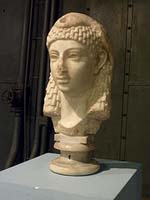Cleopatra VII
Immortalized in books, movies and a Shakespearian play, Cleopatra VII Thea Philopator became Egypt’s most popular ancient Egyptian ruler. Known simply as Cleopatra, she would lead her country despite its declining power.
Raised to Rule

© Tiffany Silva - Statue of Queen Cleopatra
For more than 300 years, Cleopatra’s family ruled Egypt. She was born the third child of King Ptolemy XII in 69 BC. Her name meant “glory of the father”. Cleopatra's two older sisters died before her father, leaving her with the rights due to the firstborn child.
Although it is not clearly stated in historical texts, some Egyptologists speculate that Cleopatra’s mother was the king’s sister, Cleopatra V Trypaena. Other historians point to texts that indicate that she was an illegitimate child of the king.
Debate exists over the ethnicity of Cleopatra. While most scholars consider her to be of Greek lineage, a few argue that she was of African blood. In either case, the Ptolemy family was not of Egyptian origins.
Little is known of Cleopatra’s childhood, except that she was being groomed as the future leader of the country. Unlike the rest of her family, Cleopatra took great interest in Egyptian history and religion. She was the only member of her family to learn the Egyptian language.
Cleopatra became co-ruler of Egypt at the death of her father in 51 BC. Egyptian law forced her to share her new role as pharaoh with Ptolemy XIII, her younger brother. In fact, she would never be the sole ruler of Egypt in name, sharing the official title with her brothers and her son.
Divine Queen
At only 18 years old, Cleopatra became Queen of Egypt. She was most likely married to her brother, who was eight years younger. The young couple ruled an empire that included Egypt, Cyprus, parts of Libya and various Middle East territories.
Cleopatra used the Egyptian religion learned during her childhood to identify herself as the new version of the goddess Isis. By also later fashioning herself as the goddess Aphrodite, she revealed her family’s Greek roots.
Egyptian texts reveal Cleopatra to be very popular leader among her own people. In a papyrus dated 35 BC, Cleopatra is referred to as “Philopatris”, or “she who loves her country”.
The Queen carefully crafted a pageantry of luxury and embellishment, although she was not simply the golden seductress featured in Hollywood movies. Egyptologists consider her ability to reinvent herself to fit any situation to be a key part of her brilliance in politics.
Ancient Egyptian records reveal Cleopatra to be an intelligent and powerful ruler. The philosopher Plutarch described her not as a stunning beauty, but as a captivating, persuasive and charming leader.
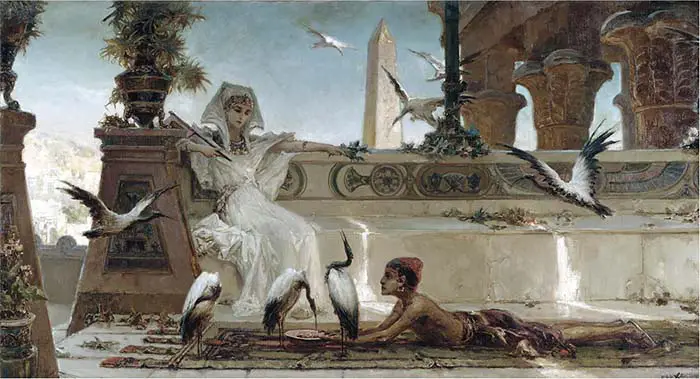
@ Sofi - Cleopatra, painting by Vasily Alexandrovich Kotarbinsky
Roman Influence
Although Egypt remained a large and wealthy empire, a new, more powerful force was rising. In 168 BC, almost 100 years before Cleopatra’s birth, Rome became an overseer of Egypt and the Egyptian royal family. An alliance between the two empires helped keep the Ptolemy family in rule over their fading empire.
At the death of Cleopatra’s father, the Roman leader Pompey was appointed guardianship over Cleopatra and her brother. His duty was to ensure tributes were paid to Rome on behalf of Egypt.
Sibling Rivalry
Approximately one year into her reign, Cleopatra took advantage of the age difference and decided to ignore the co-regency of her brother. She removed his name from all official documents. Craftsmen designed legal tender featuring her name and image.
For three years, the Queen ruled without regard to her brother. During this time, she began to worry court officials by her actions. They considered her brother easier to control, so they plotted to overthrow her in favor of her brother.
In 48 BC, her brother, under the care of his advisors, forced Cleopatra to flee from the royal capital of Alexandria. She reacted by forming an army among the Arabian tribes east of Pelusium.

@ Jason Devaun - Cleopatra, depiction on a Ptolemaic coin
Roman Invasion
While Cleopatra fought to regain control of Egypt, the Roman guardian Pompey was fighting his own battles against his fellow Romans.
Pompey sought refuge with Ptolemy XIII only to be murdered the moment he arrived at Alexandria. Four days later, Julius Caesar arrived in Alexandria with 3,200 legionaries and 800 cavalry soldiers. Twelve additional soldiers wore the insignia of Rome and carried representations of authority from the Roman Empire.
Riots broke out throughout the capital city. Caesar took control of the royal city and began the process of restoring order. Although Ptolemy fled after Caesars arrival, his advisors returned him in order to confer with Caesar. Cleopatra acted quickly to ensure that she would be the sole ruler of Egypt.
Click here to discover more about Egypt's Roman period
Wrapped in a Rug
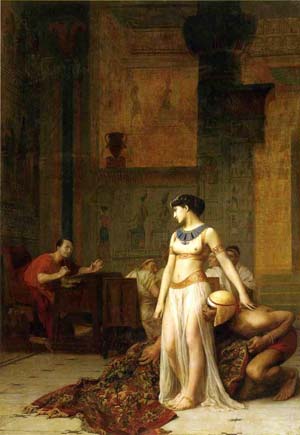
Cleopatra before Caesar, by Jean-Léon Gérôme
Dressed in her finest, Cleopatra arranged to be smuggled past the Roman guards and into the palace rolled inside of a rug. She was only 21 years old, while Caesar was 52. Historians believe that Caesar was amused by her brilliant strategy.
In addition to a personal attraction, a relationship between Cleopatra and Caesar would greatly benefit them both. Caesar was known for accumulating high levels of debt. Cleopatra wished to be restored to power, which would make her the richest woman in the world.
Ptolemy quickly became aware that Cleopatra had formed an alliance with Caesar that could not be broken. He became irate, screaming through the streets of Alexandria as he fled.
Alexandrian War
Ptolemy had no intention of giving up his throne so easily. Under the leadership of the young co-regent’s advisor, Ponthinus, 20,000 soldiers surrounded Alexandria in 47 BC. During the resulting battle, parts of the Alexandrian Library were destroyed by fire.
Caesar’s forces maintained an upper hand by maintaining authority over the Pharos lighthouse and the harbor. Ptolemy drowned in the Nile while trying to flee. Ponthinus was executed.
During the battle, Cleopatra’s younger sister, Arsenoe, declared herself the Queen of Egypt. She was quickly captured by Caesar’s forces.
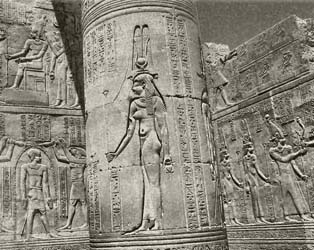
© Mohamed - Cleopatra relief at Kom Ombo
Continued Co-Regency
At the death of her brother, Cleopatra became the sole ruler of Egypt. Despite the years of chaos and confusion, the Egyptian priests and people still held tightly to their traditions and customs. In ordered to be fully restored to her throne, she was required to marry another younger brother, who became Ptolemy XIV. He was only 11 years old and appeared to not be active in the rule of Egypt.
Cleopatra and Caesar
On June 23, 47 BC, Cleopatra gave birth to her first son, Caesarion. Also known as Ptolemy Caesar, the child represented a vital connection between Rome and Egypt.
In 46 BC, Caesar returned to Rome. Cleopatra, her son and younger brother arrived a year later. Cleopatra fashioned herself as an Egyptian goddess, offending the conservative Republicans. As the “New Isis”, she insisted on the finest luxury. In contrast, Cleopatra’s sister, Arsenoe, was paraded through the streets as a conquered slave when she arrived in Rome in chains.

@ jean louis mazieres - Caesar and Cleopatra, painting by Pietro Berrettini
Caesar openly claimed their son and declared he would marry Cleopatra despite laws against bigamy and foreign marriage. Upon his orders, a gold-plated statue depicting Cleopatra was placed in the temple of Venus Genetrix.
Caesar continued to conquer his rivals with Cleopatra by his side. He had politically placed himself as dictator of Rome.
On March 15, 44, a conspiracy formed by Roman senators resulted in the assassination of Julius Caesar outside of the Senate Building in Rome. They feared that Caesar was planning to take over the Republic by declaring himself a god.
Cleopatra and her son were not named in Caesar’s will. A month after his death, her family returned to Egypt. Upon arriving, her brother Ptolemy XIV died of poisoning. Cleopatra was now the sole ruler of Egypt.
She waited and watched Rome closely for indications of who would be the next powerful leader.
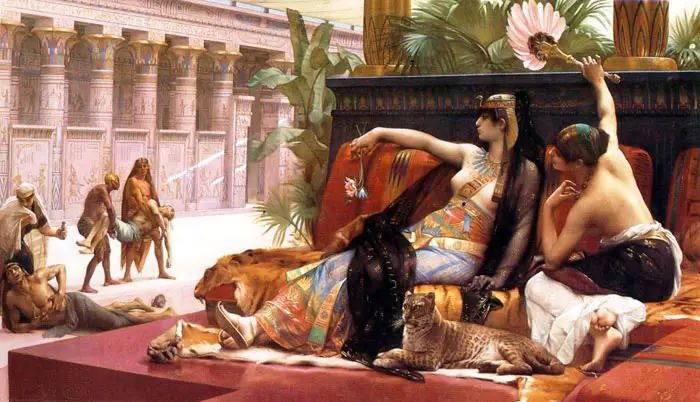
Cleopatra testing poisons on condemned prisoners, painting by Alexandre Cabanel
Becoming Aphrodite
By successfully defeating Caesar’s enemies, the Roman Mark Antony became a powerful leader in Rome. In 41 BC, Antony invited Cleopatra to Tarsus to discuss her aid in his campaign against the Parthian Empire. Through her years of careful planning, Cleopatra knew that Antony was a different man the Caesar.
Instead of arriving rolled in a rug asking for help, she arrived in splendid glory. Although Egypt was now on the brink of bankruptcy, Cleopatra arrived in Tarsus on a ship outfitted with silver oars. Purple sails announced the arrival on not only a queen, but a goddess. Dressed as Aphrodite, the goddess of love, she captured the attention of the womanizing Mark Antony.
He was so charmed by her that he abandoned his plans and left with her for Alexandria. At her request, he ordered the execution of her younger sister in Rome, Arsenoe.
Within a year, Cleopatra gave birth to twins, one boy and one girl. Mark Antony had returned to Rome and did not see Cleopatra for four years. When he finally returned to Egypt, he reunited Cleopatra and his children. He officially recognized them as his children and named them Alexander Helios and Cleopatra Selene.
Despite already being married, Mark Antony married Cleopatra in Antioch in 37 BC. Antony’s Roman wife, Octavia remained loyal to him, but her brother, Octavian, was outraged.
Cleopatra and Mark Antony
Cleopatra's love story with Mark Antony benefited both in many ways. Mark Antony gifted Cyprus, Phoenicia, the Sicilian coast, Coele-Syria, Arabia and Judea. This gift allowed Egypt to build ships from Sicilian lumber. Egypt build a large and impressive fleet. Many Romans began to turn their back on Antony.
Antony planned a Roman campaign against the Parthians using Egypt’s support. In 36 BC, he was defeated by the Parthians and returned to Alexandria. Cleopatra then gave birth to their son, Ptolemy Philadelphos.
In 34 BC, Antony led a successful campaign into Armenia. He gifted the conquered country to his oldest son, Alexander Helios. To celebrate, Cleopatra led a parade though Alexandria. Dressed as the New Isis, she presented Antony as the New Dionysus.
The celebrations culminated in a political ceremony to give royal titles to the family. With Anthony’s guidance, Caesarion was named Ptolemy XV and made co-regent with his mother. Cleopatra was named the Queen of Kings. The remaining children all received titles and kingdoms of their own.
@ Mark Antony and Cleopatra, painting by Lawrence Alma-Tadema
By 34 BC, Antony had formally divorced his Roman wife, Octavia. He placed Cleopatra’s name and face on the silver denarii, official Roman currency. These actions angered many Romans and built a following for Octavian.
Octavian took Mark Antony’s will from the Vestal Virgins temple and published the contents. Antony’s will contained provisions to turn the Roman Empire over the Cleopatra. It would also move the capital from Rome to Alexandria.
Octavian, with the backing of Rome, officially declared war against Cleopatra.
Naval Defeat
In 31 BC, Octavian’s naval forces attacked Antony and Cleopatra’s navy at Actium. Cleopatra became afraid of being captured and removed her ships from the battle. Mark Antony’s forces were not strong enough on their own and were defeated. His army surrendered, although he retreated to Alexandria and avoided capture. After receiving false word of his wife's death, he killed himself with his sword.
Death by Snakebite
Cleopatra was ordered to appear before Octavian. He explained to her that her days as a Queen were over. She would be taken through the cities she had ruled in shame as a slave.
Egyptian religion provided her an escape. Death by snakebite would provide her with immortality.
On August 12, 30 BC, she had an asp brought to her hidden inside a basket of figs. Holding it to her breast, she ensured that she would be remembered as a Queen and not a slave. She was only 39 years old. She was buried with Mark Antony.
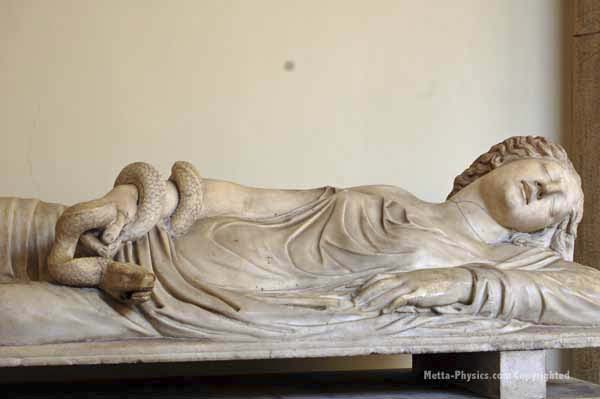
@ Metta-Physics Magazine - Statue of Cleopatra with her snake
The End of Egyptian Rule
The death of Cleopatra ended centuries of Egyptian pharaohs. The Roman Emperors took over control of Egypt. Octavian was named Caesar Augustus. While some historians note that Cleopatra was succeeded by her son Caesarion as the last pharaoh, he never actually ruled. He was strangled to death. The children of Antony and Cleopatra were raised by Antony’s ex-wife, Octavia.
Discover more about The Fall of Ancient Egypt
While many images of Cleopatra limit her to a sex object, historians note that Cleopatra was a highly intelligent leader. Her accomplishments held together the Egyptian Empire during its decline.
Quick Facts
- Cleopatra was not actually Egyptian, but of Greek descent, her family having ruled Egypt for over three centuries.
- She was born in 69 BC. Died on August 12, 30 BC.
- She is officially known as the last pharaoh of Egypt. Her son, Cesarion, was killed before he could succeed her to the throne.
- Never officially ruled on her own. She always had a co-regent.
- Although not known for exceptional beauty like other Egyptian queens, Cleopatra's accomplishments came through her intelligence and sense of diplomacy.
- She secured the Roman Empire as an ally through her relationships with Caesar and Mark Antony.
- Her rule came to a end after the death of Mark Antony, when she ended her life by snakebite.

